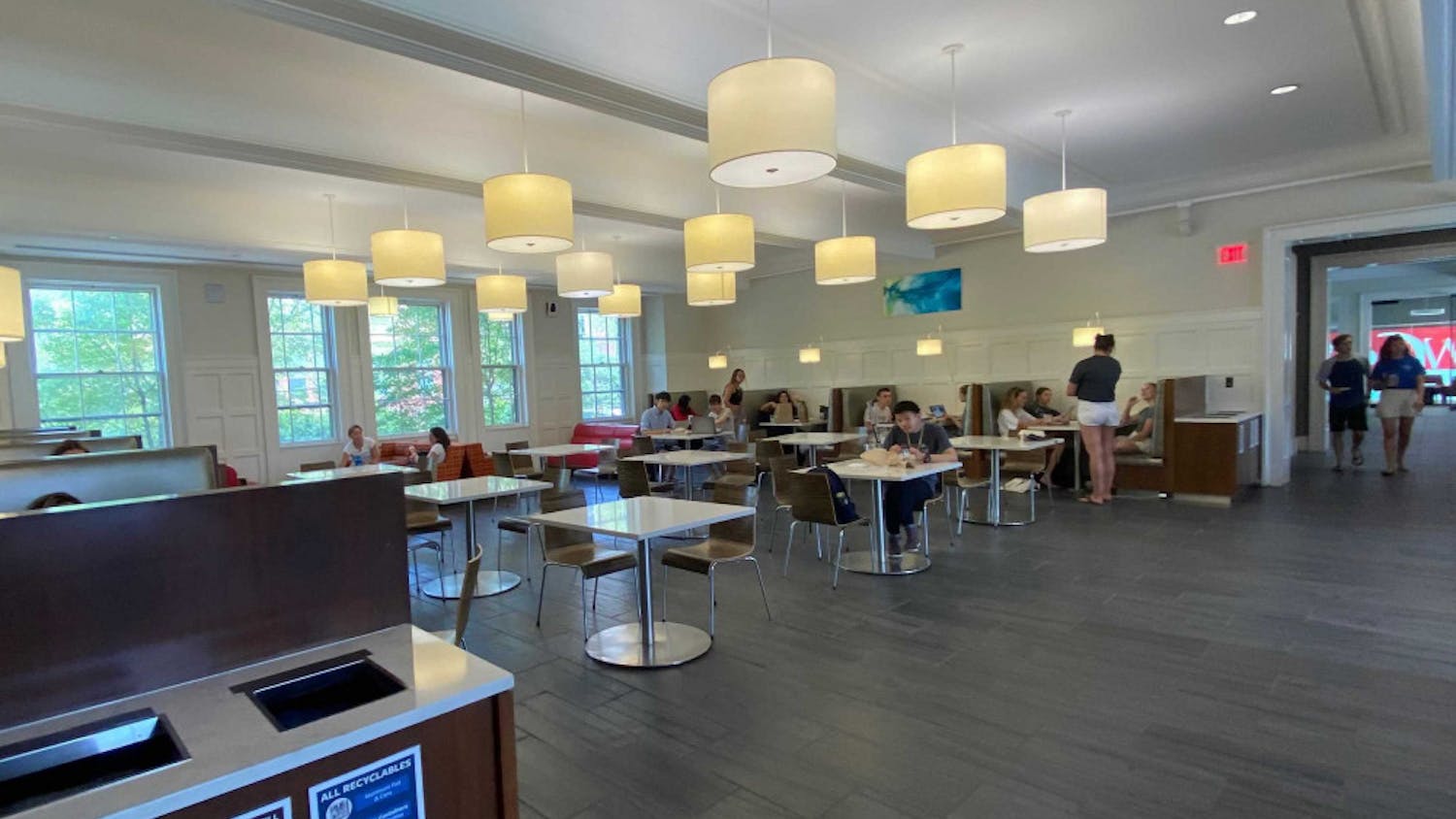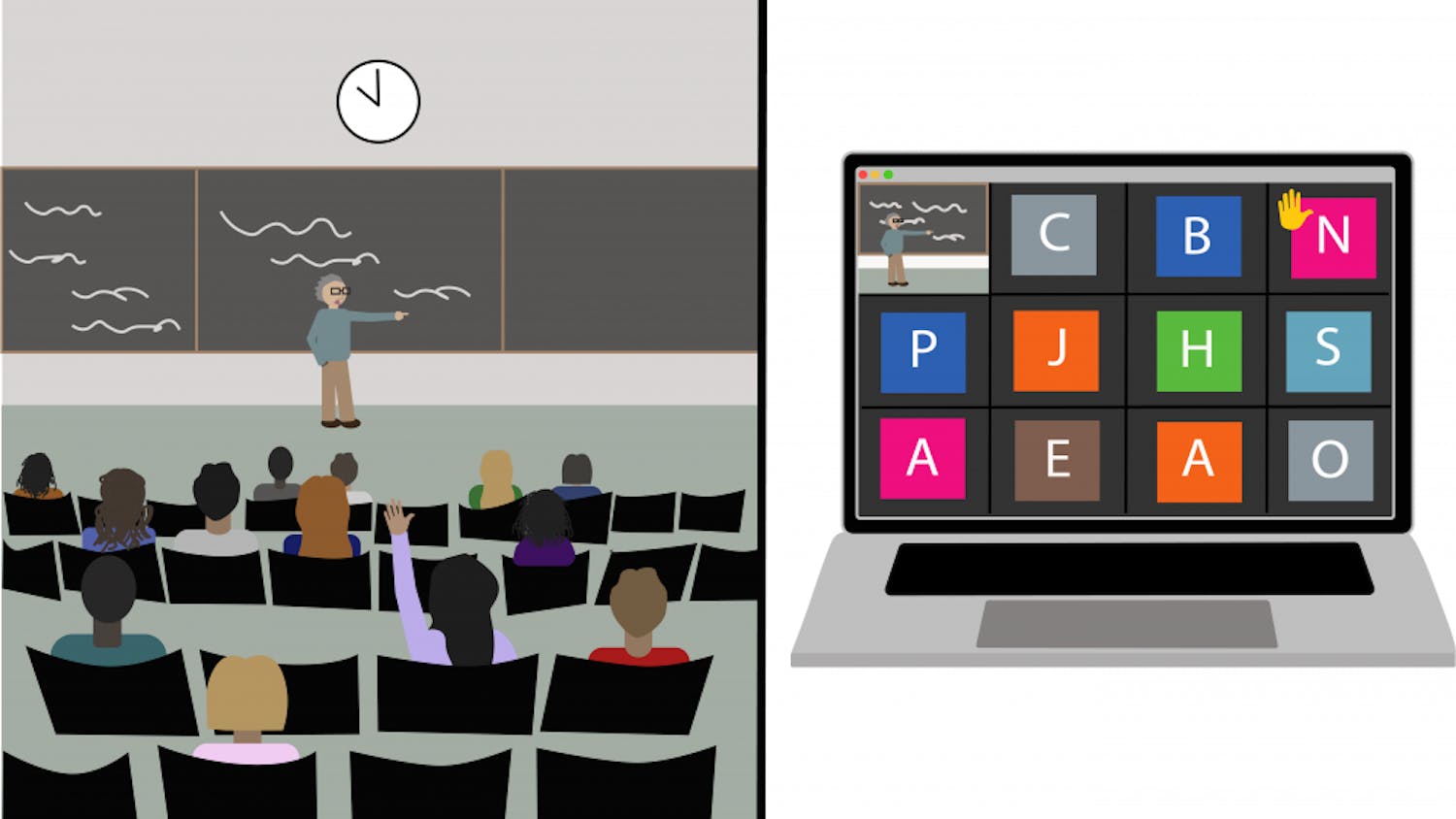Every great pair is a study of complementary contrasts. In a duo that succeeds, one ultimately finds the weakness in the other and improves upon it, turning a liability into an asset. The men's tennis team is riding the strength of its own odd couple in the pursuit of Brown's second men's Ivy League title since 2002.
Four years ago, co-captains Adil Shamasdin '05 and Nick Goldberg '05 joined the men's tennis team, leading the Bears to their first championship in the history of the program. Now, in their final season of collegiate tennis, the team's lone seniors are trying to go out the same way they came in.
Despite their mutual goals, Shamasdin and Goldberg could not be more different. Wiry and quick, Shamasdin is a sparkplug on the court, exhibiting an artistry better showcased by a basketball point guard or a football running back. He charges the net like a bull and plays a confident game, relying on his hyperactive attack to wear down his opponents.
"Everything is fast. He looks to come forward and attack. Adil has an uncommon combination of very quick hands and quick feet. Usually a tennis player has one or the other," said Head Coach Jay Harris.
Goldberg's game, meanwhile, is about power and defense. With a serve that regularly tops 125 mph, according to Harris, he can blow the ball past an opponent before he even has a chance to move toward it.
"(Goldberg's) backhand was always a huge weapon; now we have made his forehand another weapon," Harris said. "Nick will primarily play from the backcourt - he has good defense."
Although Shamasdin and Goldberg both ended up in Providence, their road to the Renaissance City could not have been more different.
Goldberg, a native of Albuquerque, N.M., was drawn to the Ivies, deciding between Yale and Brown, ultimately settling on Brown due to its mix of excellent academics and a laid-back atmosphere.
Shamasdin, from Pickering, Ontario, had no intention of pursuing an Ivy education, and it was only a form filled out on a whim that brought him here.
"I just filled out the recruiting sheet," Shamasdin said. "I was looking at (the University of the) Pacific and (the University of) Kansas, and I got offers from both. But then, (then-Assistant Coach) Matt Halfpenny came up to Nationals and said they thought they could improve me. They had faith in me and believed me."
Halfpenny and then-Head Coach Jon Choboy's recruiting pitch sold Shamasdin, who was especially impressed with the close-knit atmosphere of the team.
"It was very family-like, very supportive of what I wanted to do," Shamasdin said.
Shamasdin's and Goldberg's first year at Brown was arguably the most successful in team history, capped off by a stunning defeat of Harvard to win the Ivy title. It was Shamasdin who delivered the winning point for Brown in an acrobatic feat that Goldberg refers to as "the shot heard 'round the Ivies."
After being down a break at 4-3 to Harvard senior Will Lee, Shamasdin battled back to take the lead at 5-4. With the teams knotted at 3-3, Shamasdin came to within one point of securing the clinching fourth victory.
"He hit an approach and got as close to the net as I have ever seen without touching it," Goldberg said. "Lee hits a passing shot, everyone knew that it was out of Adil's reach, he stretches out with a forehand volley, and angles it right past him."
The title would not have been within Bruno's reach, however, had it not been for Goldberg's earlier victory for a crucial point over Harvard's Oliver Choo.
While the victory was a huge boon to the men's tennis program, the pressure of living up to his first year often plagued Shamasdin during his follow-up campaign.
"I felt like my sophomore year, in terms of academics and tennis, was a slump," he said. "I put a lot of pressure on myself, but felt I could play a lot better. I had a decent amount of wins, but matches I really wanted to win I ended up losing."
To complicate matters further, Choboy and Halfpenny left Brown in the offseason to take matching positions at North Carolina State University. Harris' more relaxed coaching style was a complete about face from the in-your-face Choboy.
"(The coaches' departure) also had a lot do with my sophomore slump," Shamasdin said. "One of the main reasons why I came here was for them. When they left, part of me left. I wasn't happy to play with (Harris). I was being selfish and stubborn."
Goldberg also had a tough time coping with Choboy's departure, but in many ways he felt Harris' style was a better fit.
"I was working for Coach Choboy and he brought me the news in person," Goldberg said. "Coach Harris and Choboy are polar opposites. Choboy would get in your face all day and ride you; Harris is laid back, encourages self-motivation. That style worked a little better for me - my game started to come out a little bit."
Shamasdin and Harris eventually worked out the bumps, as he and Goldberg reached the finals of the Omni Hotels Regional Doubles Championship that season. The duo at one point was ranked as high as 26th in the country.
"If you convert (our doubles) to volleyball, I would be the setter and he would be the hitter," Goldberg said. "He can put balls away from anywhere and I get him as many looks at the net as possible."
Despite the strong doubles finish, Shamasdin's general disappointment with his sophomore season led him to move away from tennis over the offseason.
"I regrouped myself, didn't touch a racket over the summer," he said. "It allowed my body to rest and my mind to rest and stay away from tennis."
Instead of hitting the courts, Shamasdin headed to Boston, where he worked at a program called Tenacity, teaching tennis to inner-city children.
The time away helped - Shamasdin had arguably his most successful season the following year, making it to the round of 16 of the NCAA doubles tournament with Jamie Cerretani '04, with whom he was ranked as high as seventh in the country, before falling to the No. 2 team from the University of Georgia. Shamasdin's performance in both singles and doubles earned him a Second Team All-Ivy selection, while the team went 20-6 and finished second in the league at 6-1.
Goldberg also had a successful year. After developing a better all-around game in his sophomore season, he took a firm hold of the no. 2 singles spot, picking up 29 wins in singles and 25 in doubles.
"He got a lot stronger. His serve got bigger," Harris said. "A lot of coaches around the country have said how much he improved. We vote every year on most improved, and Nick has gotten it each of the last two years."
Coming into the 2004-2005 season, the lone rising seniors knew they would have to step up as leaders for what would be a young team and make up for the loss of three players to graduation.
"We had lost three guys, all playing (in the) doubles lineup," Goldberg said. "It was a big unknown. The year before, we had come in knowing we had a solid core coming back, but this year there were a lot of guys fighting for spots."
"We knew other teams lost a lot as well," added Shamasdin. "We weren't down on ourselves."
The leadership of Shamasdin and Goldberg erased any doubts of a down season, and they helped bring each other's game to a new level at the same time.
"Nick is a guy that is always emotionally stable, keeps things in control, very motivated. He rarely has a bad practice, and if other guys are, he gets on them," Harris said. "Adil is more of an emotional person. When they are high and positive it's crazy to be around them, like they are sending out electric shocks."
The duo has truly come through for Brown, pushing the Bears to a 20-5 overall record and a No. 38 ranking.
"On the court, they are the fiercest competitors in the Ivy League," said teammate Phil Charm '06, who played doubles with Shamasdin for most of the season. "Adil is a little more quiet, but there is a fire burning in him. He is able to flick a switch and get everyone, including himself, fired up."
While Shamasdin tends to lead by example, Goldberg is more of a vocal presence, said teammate Richard Moss '06.
"Nick has much more of a commanding feel," Moss said. "Nick is the brain box of the team. It has been fantastic to look up to the way he manages academics and athletics. He is a remarkable student and just as good a tennis player."
Off the court, though, the roles are reversed. Goldberg spends his time involved in activities such as the Lecture Board, while Shamasdin is more likely to be found spinning at his turntables.
"Nick is the definition of the student-athlete at Brown," Charm said. "Adil is much more alternative. He focuses on music and DJ'ing."
Shamasdin, a psychology concentrator, is contemplating a career in music or video production, but for the immediate future is hoping to return to Toronto in preparation for joining a pro tennis tour. Goldberg, who is concentrating in political science, plans on working on a congressional campaign this summer with the intention of applying to law school at a later date.
With three matches left in the regular season, both Goldberg and Shamasdin are close to cementing themselves at the top of Brown's all-time career wins records. Shamasdin is currently third in career singles wins with 98, with Goldberg just behind him at 93. The same is true for career doubles victories, where Shamasdin is second all-time with 111 and Goldberg is third with 96. With four more victories combined, Shamasdin will surpass former doubles partner Cerretani for the most total career victories.
But for the time being, the accolades can wait. The Bears are on a mission for a championship, and Goldberg and Shamasdin, now back together playing first doubles, know that they have a special role to play as the only members remaining from 2002's Ivy Championship team.
"We are the only ones left that know what it takes to win a title," Goldberg said. "We are trying to finish off our careers the way it started."




